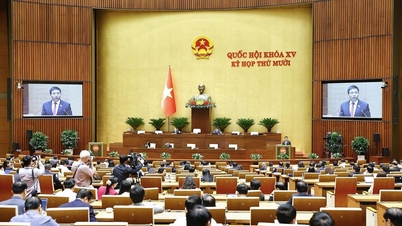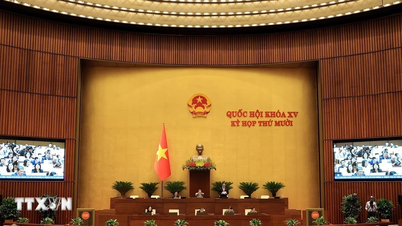Regarding the adjustment of the National Master Plan for the 2021-2030 period, with a vision to 2050 , Minister Nguyen Van Thang said that the plan was adjusted to suit the new context after the rearrangement of administrative units at all levels and the implementation of a two-level local government model.
According to the Minister, the planning has adjusted the GDP growth rate for the 2026-2030 period to reach 10%/year or more, the labor productivity growth rate to reach over 8.5%/year; by 2030, GDP per capita will reach about 8,500 USD, the human development index (HDI) will reach 0.78...

Minister of Finance Nguyen Van Thang presents a report. Photo: National Assembly
The socio -economic regions according to the plan approved by competent authorities include 6 regions, of which 2 regions have fundamental changes compared to before: the North Central region including 5 provinces and cities (from Thanh Hoa province to Hue city) and the South Central Coast and Central Highlands region including 6 provinces and cities (from Da Nang city to Lam Dong province).
The additional master plan for the North Central dynamic region includes coastal areas of the three provinces of Thanh Hoa - Nghe An - Ha Tinh .
The Northern midlands and mountainous region includes 9 provinces. | Lang Son, Cao Bang, Thai Nguyen, Tuyen Quang, Phu Tho, Lao Cai, Lai Chau, Dien Bien, Son La |
The Red River Delta includes 6 provinces and cities. | Hanoi, Hai Phong, Ninh Binh, Hung Yen, Bac Ninh, Quang Ninh |
The North Central region includes 5 provinces and cities. | Thanh Hoa, Nghe An, Ha Tinh, Quang Tri, Hue |
The South Central Coast and Central Highlands region includes 6 provinces and cities. | Da Nang, Quang Ngai, Gia Lai, Dak Lak, Khanh Hoa, Lam Dong |
The Southeast region includes 3 provinces and cities | Ho Chi Minh City, Dong Nai, Tay Ninh |
The Mekong Delta region includes 5 provinces and cities. | Can Tho, Vinh Long, Dong Thap, An Giang, Ca Mau |
The Minister of Finance said that the additional planning orients to strengthen infrastructure connecting central urban areas in newly merged provinces and cities associated with reasonable sharing of roles and functions; orients the development of Ho Chi Minh City to become a megacity following a multi-polar, multi-center model, reaching international standards.
For important economic sectors, the orientation of rapid development of economic sectors contributes to achieving the target of double-digit growth; focusing on developing fundamental and strategic industries; developing large-scale industrial clusters and modern industrial park models.
Regarding the development of social and technical infrastructure, additional orientations are given to upgrading higher education facilities, developing specialized hospitals in provinces and cities, and investing in communal health care. Social infrastructure is also supplemented with orientations for developing cultural industries and building large-scale cultural and creative complexes.
Social and technical infrastructure is also supplemented with the orientation to accelerate the construction of highways, railways, seaports, airports, energy infrastructure, and digital infrastructure to meet the requirements of high economic growth...
Presenting the review of the above content, Chairman of the Economic and Financial Committee Phan Van Mai said that the Committee basically agreed to supplement and adjust the contents of the national master plan to suit the new context after the administrative unit arrangement.
However, for regions and localities with adjustments to administrative boundaries and new names, the review agency recommends carefully reviewing the planning content and names of regions and provinces to edit them consistently, avoiding different interpretations, causing difficulties in concretizing when implementing the resolution.

Chairman of the Economic and Financial Committee Phan Van Mai presents the audit report. Photo: National Assembly
The Economic and Financial Committee found that the basic socio-economic zoning remains the same with 6 regions. However, the structure and scope of each region have changed significantly in terms of the number of provincial administrative units, the size of the area and population due to the impact of the arrangement and merger of provincial administrative units. The North Central region, the South Central Coast and the Central Highlands are the two regions with the most significant changes compared to before.
Therefore, the Committee proposed to clarify how the new zoning plan will impact and influence the development orientation of each region, and assess the internal connectivity of each region.
Prime Minister approved national land use and marine spatial planning
Regarding the Law on Planning (amended) , Minister Nguyen Van Thang said that the draft law supplements and adjusts general principles for detailed sectoral planning. Specialized laws will provide detailed and specific regulations on the establishment, appraisal, approval, publication, adjustment and content of detailed sectoral planning, urban and rural planning.
The planning system includes: National-level planning (national master planning, national marine spatial planning, national land use planning, sectoral planning); regional planning; provincial planning; detailed sectoral planning; urban and rural planning; planning of special administrative-economic units as prescribed by the National Assembly.
The Minister of Finance said that the drafting agency has reviewed and reduced the number of plans in the list of sectoral plans and detailed sectoral plans, the number of plans has been reduced from 78 to 49 plans (a decrease of 37%).
Notably, the draft regulations strengthen decentralization and delegation of authority in planning activities.
The Prime Minister is authorized to approve national maritime spatial planning and national land use planning. The Government details the authority to approve sectoral planning to ensure flexibility in direction and administration. Ministers are authorized to approve detailed sectoral planning. Provincial Chairmen are authorized to approve provincial planning.
To ensure post-inspection work and limit arbitrary planning adjustments, the Minister of Finance stated that the draft law supplements regulations on monitoring, inspecting, and reviewing planning.
Vietnamnet.vn
Source: https://vietnamnet.vn/trinh-quoc-hoi-de-xuat-6-vung-kinh-te-xa-hoi-sau-sap-nhap-tinh-2460302.html







































































































Comment (0)